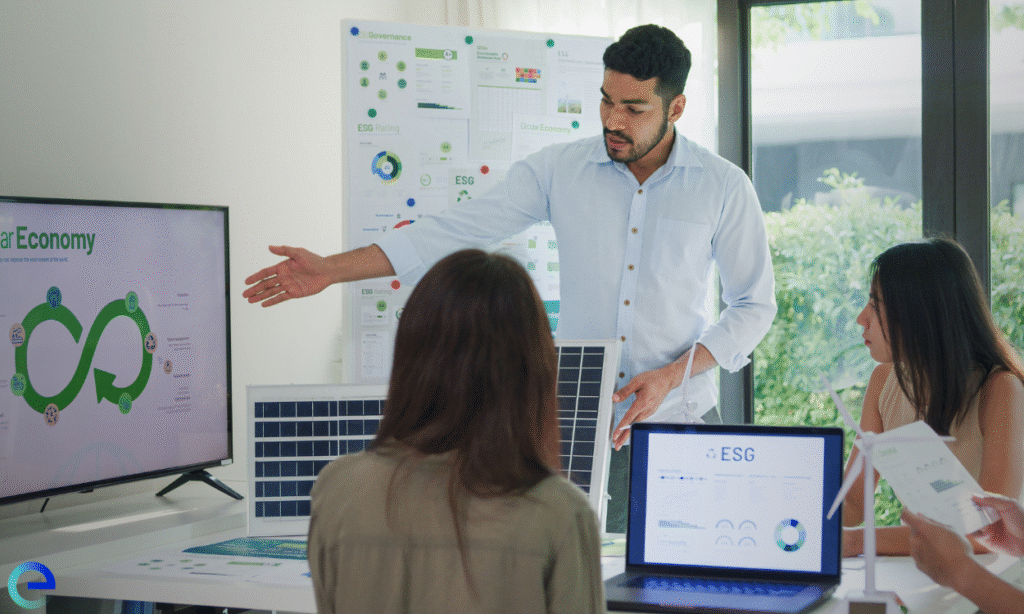
The circular economy in business offers enormous potential, as it can create a $4.5 trillion economic chance.
This is not a projection that can be ignored. Companies are moving faster toward this production and consumption approach as they realize its major benefits. The Ellen MacArthur Foundation’s research shows circular economy practices can cut greenhouse gas emissions by 39% and resource extraction by 28% by 2030.
The business advantages extend beyond just environmental impact. More companies are driven by growth and competitiveness to implement circular economy business principles because they have seen in numbers how much they can save in material costs if they take circular initiatives. Consequently, organizations with unique perspectives tend to favor regenerative approaches over traditional linear models.
The change in consumer priorities and their care about the environment pushes businesses to embrace circular principles.
This piece examines how companies can create a circular economy in business through grounded case studies and practical strategies that turn sustainability challenges into competitive edges.
The circular economy in business shows us a new way of working within nature’s limits. Companies now see this sustainable alternative as good for both the environment and their bottom line.
A circular economy keeps materials from becoming waste and helps nature thrive. Products and materials stay useful through maintenance, reuse, refurbishment, remanufacturing, recycling, and composting.
The circular economy stands on three main principles:
This method tackles climate change, biodiversity loss, waste, and pollution. It separates economic growth from using up finite resources. The Ellen MacArthur Foundation calls it a “systems solution framework” because small changes can’t fix big environmental problems.
The old linear economy works like this: take resources, make products, use them, and throw them away. Raw materials get extracted, turned into products, sold, and end up as waste.
Here’s what makes circular systems different from linear ones:
Resource Flow: Linear models create waste at the end. Circular systems keep materials moving through the economy.
Product Design: Linear economies make products that break down quickly to sell more. Circular design focuses on products that last, can be fixed, and can be recycled.
Value Creation: Linear businesses make money just from selling products. Circular companies find many ways to profit throughout a product’s longer life.
Environmental Impact: Linear systems waste resources and pollute. Circular systems plan ahead to avoid waste.
Companies see more reasons to go circular each year. Building a circular economy in business doesn’t only offer benefits such as helping the environment; there are real advantages that surface and are worth the focus.
A circular economy could create more jobs (700,000 in the EU by 2030) and boost growth. European businesses could share €1.8 trillion in benefits by 2030 – that’s €0.9 trillion more than sticking with linear models.
The benefits add up:
Natural resources keep shrinking, and environmental pressures grow stronger. Businesses that adopt circular principles now will thrive in an economy that rewards green practices.
The shift to creating a circular economy in business models begins with finding the best opportunities. Companies need systematic analysis to understand how resources move through their operations and where they lose value.
Material Flow Analysis (MFA) lays the groundwork to transform into a circular business. This method helps measure the stocks and flows of materials, components, and products throughout their value chain. Companies learn about where materials come from, how they move through production, and where they end up.
The Eurostat Sankey diagram shows this concept well. It maps out the amounts of materials extracted, imported, recycled, or disposed of, along with their emissions. The European Union’s circularity rate is just 11.8% right now, which shows there’s plenty of room to improve.
Material flow mapping works at different levels. For example, there is the macro-level for entire economies, the meso-level for industry sectors, the micro-level for individual businesses, and finally the nano-level for specific products.
Value leaks happen when resources don’t deliver their full worth. Supply chains of all sizes lose substantial economic value through poor production, early disposal, and weak recovery systems. To cite an instance, businesses lose over $400 billion yearly just from plastic disposal.
Companies can spot these inefficiencies in several ways:They should map value streams to see operational workflows and find bottlenecks, excess inventory, and demand issues. This gives them a clear picture of where to optimize.
Teams can track material throughput to find underused or wasted materials. The construction sector in the UK’s West Midlands region wastes about £5 billion worth of materials each year in landfills.
Business models need a fresh look to capture value from multiple product or material lifecycles.
The right assessment tools can boost how we spot circular opportunities. The Ellen MacArthur Foundation launched Circulytics in 2020, offering one of the most detailed circularity measurement systems available. More than 2,000 companies use this tool to assess circularity across their operations, not just products or material flows. Circulytics looks at circularity through various indicators like strategy integration, people and skills capabilities, systems, processes and infrastructure, and innovation development.
Companies often use Life Cycle Assessment (LCA), Life Cycle Costing (LCC), and Cost-Benefit Analysis (CBA) for specific sectors. These methods measure environmental effects and economic benefits of different circular strategies.
Waste walks are hands-on site inspections that help spot immediate ways to improve. Combined with broader assessment frameworks, they give a full picture of where circular principles can add the most value.
A successful circular strategy needs careful planning after spotting opportunities. Companies must rethink their product design, pick the right business models, and build networks that work together to turn circular ideas into reality.
Three key elements make circular product design work well. Physical durability helps products last longer through repeated use. Companies like W.L. Gore and Lacoste have created detailed testing protocols that copy real-world wear and tear to make products that last.
Emotional durability keeps products desirable as they move between users or stay useful for longer periods. Beyond Retro achieves this by making each product unique.
Design for disassembly and recyclability lets products break down into parts for remaking or recycling. Napapijri shows this approach with its Circular Series jackets. These jackets use just one type of recyclable polymer, which makes them simple to process at the end of their life.
Circular business models create and deliver value while reducing environmental and social impact. Companies should review which models fit their value chain best:
Product-as-a- Service models allow customers to lease or pay per use rather than purchase outright, as seen in HP’s Instant Ink program. Sharing platforms such as Fat Llama enable people to buy, sell, or rent items, promoting access over ownership. Product life extension focuses on durability and reuse through repair, redesign, or refurbishment—like Apple’s certified refurbished products. Resource recovery turns discarded materials into new products, exemplified by Rede Asta’s corporate gifts. Finally, circular supplies involve sourcing and designing products in more sustainable ways, such as Google’s approach to reusing server hardware.
However, money still matters most. Companies need revenue models that stay profitable, such as subscriptions, buyback programs, reselling, or shared pricing. Swedish steel company Sandvik stands out by buying back their customers’ waste steel, which gives them valuable materials to reuse.
Everyone involved in a product’s lifecycle must work together for circular systems to succeed. This integrated approach helps suppliers and end-users close resource loops, despite some practical challenges.
Stakeholder participation serves many purposes. Companies can confirm their products work and get feedback throughout the product’s life. End-users play a key role in closed-loop and slow-loop systems.
Companies must give people reasons to participate, which sometimes means new ways of doing business. Danone shows how this works through their direct relationships with more than 58,000 farms, as they work together toward sustainable farming.
Each group brings different priorities to the table. Businesses care about infrastructure and financial resources, whereas farmers seek flexibility and long-term support. Policymakers focus on consistent regulations while researchers push for better ways to share knowledge. Success comes from balancing these different points of view through teamwork at multiple levels.
Many businesses of all sizes have proven that a circular economy in business can be both profitable and environmentally friendly.
Philips integrates circularity in healthcare through programs like Circular Edition to refurbish medical imaging systems. These systems maintain quality and reduce carbon footprints by 28% compared to new equipment. Each system saves about 25.67 tons of CO₂ emissions and reduces supply chain emissions by 60%. The company reuses over 80% (2457 kg) of original materials in every refurbished system. Their ReEntry program has successfully recovered more than 31,750 tons of post-consumer carpet tile since 2016. This shows Philips’ steadfast dedication to material circulation in the healthcare ecosystem.
IKEA runs a detailed buyback program where customers get store credit for returned furniture. The company resells evaluated items through Re-shop sections at lower prices. IKEA Family members get an extra 15% value on buyback offers. This circular initiative accepts nearly 3,000 different products, from bookcases and small tables to multimedia furniture and dining tables. IKEA also invests in green materials like FSC-certified wood and recycled plastics.
Interface has changed flooring manufacturing with closed-loop systems. Their 25-year-old ReEntry program, which started in 1995 reclaims used carpet tiles. The company has recovered over 75 million pounds of post-consumer carpet globally since 2016. Their Scherpenzeel facility in the Netherlands uses new technologies to recycle post-consumer carpet tiles that can’t be reused. The materials go right back into production. Interface also works with the Healthy Seas initiative to turn discarded fishing nets into ECONYL yarn for carpet production. This tackles marine waste while creating raw materials.
Businesses that adopt circular economy models get two major rewards through systemic change.
The circular economy brings huge financial advantages. Studies show European businesses could gain €1.8 trillion in net benefits by 2030—€0.9 trillion more than linear models. Companies save costs through material reuse, optimized operations, and lower waste management expenses. They also find new revenue streams and markets by getting value from materials they used to throw away.
The environmental impact is equally impressive. Circular models could lower global greenhouse gas emissions by 39% and reduce virgin resource use by 28%. This method rebuilds natural systems and removes waste across supply chains.
The path to circularity can be difficult with many obstacles for businesses. The high original investment costs prevent many companies from getting started, especially when they are smaller enterprises. There is also another challenge regarding people’s perception. Many customers think that refurbished products are not as good as new ones.
The primary issues include lack of awareness, money constraints, and not enough expertise. Complex operations, disconnected supply chains, and weak regulations make implementation harder.
We need systematic solutions to beat these issues and standardize circular processes to ensure consistency and growth. Strategic collaborations with logistics providers, recyclers, and sustainability experts help speed up progress.
Digital tools make tracking, predicting maintenance, and automating service management quick and simple. Of course, education plays a key role—training stakeholders about both environmental and financial benefits is everything in achieving long-term success.
The circular economy shows us a better way for businesses to grow sustainably and tackle environmental challenges head-on. Companies that follow circular principles get ahead of their competition by using resources wisely, cutting costs, and building stronger brands. It is evident that successful circular transitions need careful analysis of how materials flow, where value leaks, and which business models work best. Real-life examples from Philips, IKEA and Interface prove that circular principles work well in a variety of sectors, from healthcare to fashion.
Some challenges exist, such as upfront costs or what consumers think, alongside benefits such as alliances and digital tools that businesses should identify and take the step of reshaping their operations around circular principles. Instead, companies that are less dedicated and hesitant to develop state-of-the-art thinking are usually the ones that are left behind and miss the opportunity to lead the regenerative shift toward a more circular economy in business models.
